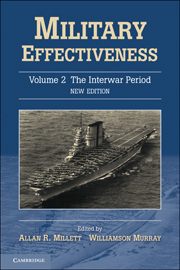Book contents
- Frontmatter
- Contents
- List of Contributors
- Introduction: Military Effectiveness Twenty Years After
- Maps
- 1 The Soviet Armed Forces in the Interwar Period
- 2 The French Armed Forces, 1918–40
- 3 The Military Effectiveness of the US Armed Forces, 1919–39
- 4 The British Armed Forces, 1918–39
- 5 Japanese Military Effectiveness: The Interwar Period
- 6 The Italian Armed Forces, 1918–40
- 7 German Military Effectiveness between 1919 and 1939
- 8 Military Effectiveness of Armed Forces in the Interwar Period, 1919–41: A Review
- Index
Introduction: Military Effectiveness Twenty Years After
Published online by Cambridge University Press: 05 June 2012
- Frontmatter
- Contents
- List of Contributors
- Introduction: Military Effectiveness Twenty Years After
- Maps
- 1 The Soviet Armed Forces in the Interwar Period
- 2 The French Armed Forces, 1918–40
- 3 The Military Effectiveness of the US Armed Forces, 1919–39
- 4 The British Armed Forces, 1918–39
- 5 Japanese Military Effectiveness: The Interwar Period
- 6 The Italian Armed Forces, 1918–40
- 7 German Military Effectiveness between 1919 and 1939
- 8 Military Effectiveness of Armed Forces in the Interwar Period, 1919–41: A Review
- Index
Summary
Ultimately a real understanding of history means that we face nothing new under the sun. For all the ‘Fourth Generation of War’ intellectuals running around today saying that the fundamental nature of war has fundamentally changed, the tactics are wholly new, etc., I must respectfully say: ‘Not really.’ Alexander the Great would not be in the least perplexed by the enemy we face right now in Iraq, and our leaders going into this fight do their troops a disservice by not studying (studying, vice just reading) the men who have gone before us. We have been fighting on this planet for 5,000 years and we should take advantage of their experience. ‘Winging it’ and filling body bags as we sort out what works reminds us of the moral dictates and the cost of competence in our profession.
More than a quarter of a century ago in the spring of 1982, the two of us wrote Andrew Marshall, the Director of Net Assessment, Office of the Secretary of Defense, that we believed that a comparative, historical case study of the effectiveness of military institutions in the first half of the twentieth century would contribute considerably to an understanding of the problems the American military confronted in the 1980s. We also believed that a transnational analysis of the world's most powerful armed forces would reveal certain persistent problems in the creation and employment of them.
- Type
- Chapter
- Information
- Military Effectiveness , pp. xi - xixPublisher: Cambridge University PressPrint publication year: 2010



